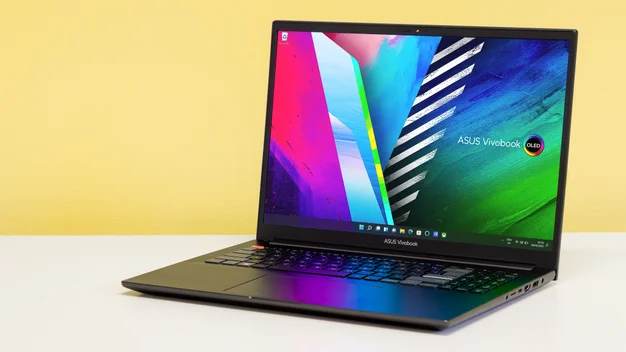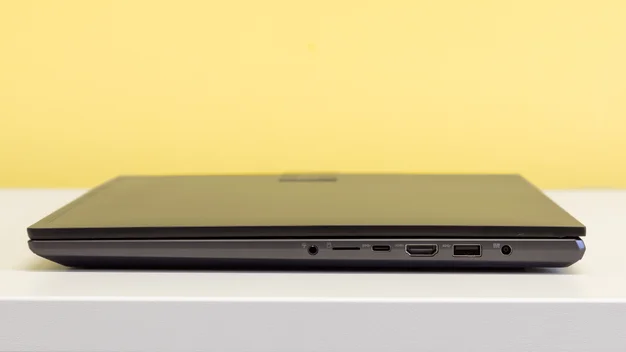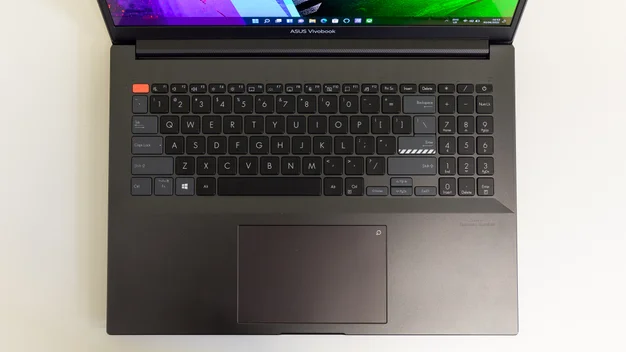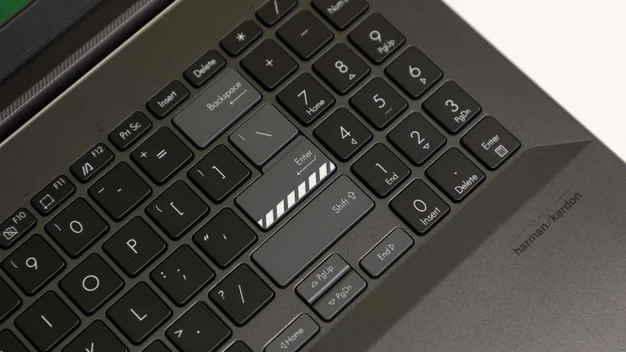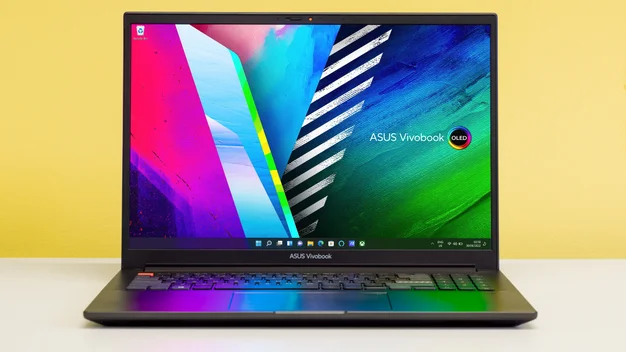Asus Vivobook Pro 16X OLED review: Big and bold
The Asus Vivobook Pro 16X OLED has a large, rich display, decent battery life and good overall performance, but it’s quite pricey
Pros
- Huge, vibrant 4K OLED display
- Great overall performance
- Battery lasts a working day and recharges quickly
Cons
- Poor colour accuracy
- No touchscreen
- No Thunderbolt support
The Asus Vivobook Pro 16X OLED is a Spartan-looking workhorse laptop with some aces up its sleeve – chiefly, a 4K OLED display, AMD Ryzen CPUs from the 5000 Series and Nvidia’s 30 Series dedicated graphics processors.
All of this points towards a big and powerful laptop that’s capable of smashing through work tasks and rendering websites, games, photos and video in beautiful, vibrant colours.
But it’s also highly portable and, with the heaviest options weighing under 2kg, it’s a laptop that’s just as happy being hauled around between meetings as it is sat on a desk, despite its sizeable 16in display.
Large but lightweight, the Asus Vivobook Pro 16X OLED means business, and it could well take the jam out of the LG Gram 16’s doughnut and be 2022’s big ultrabook of choice.
Asus Vivobook Pro 16X OLED review: What you need to know
Asus laptops with the Vivobook branding are typically cheaper and less powerful than their ZenBook counterparts and, while generally they’re good value, they haven’t always been winners. The Vivobook Pro 16X OLED looks like one, however.
The Vivobook Pro 16X OLED tells you a lot about who it’s aimed at just from its name – it’s a laptop with a 16in OLED display and it’s a laptop for work, first and foremost.
It comes with a generous helping of physical connections, meaning you’ll be spared having to shell out extra for an assortment of dongles and adapters for the great majority of situations. However, as the Vivobook Pro 16X OLED is powered by an AMD chip and not an Intel one, there’s no support for Thunderbolt, but luckily you can still connect to external displays via the HDMI port.
While there’s no Ethernet port, the Vivobook Pro 16X OLED does have an Intel Wi-Fi 6 AX200 160MHz module, so you’ll at least be able to enjoy Gigabit Wi-Fi speeds, provided you’re connected to a modern router and you’re working close enough to the access point.
While that big 4K screen will undoubtedly be the biggest draw on power, Asus has added a big 96Wh battery, so you should easily get a full day’s work out of it if you find yourself away from mains power.
READ NEXT: The best 2-in-1 laptops available right now
Asus Vivobook Pro 16X OLED review: Price and competition
Configuration tested: M7600QE – AMD Ryzen 9 5900HX CPU with dedicated Nvidia GeForce RTX 3050 Ti Laptop GPU, 32GB RAM, 1TB SSD, 16in 4K (3,840 x 2,400) OLED display, Windows 11 Pro. Price: £1,800
Two versions of the Asus Vivobook Pro 16X OLED are available, one with an AMD Ryzen 7 5800H processor, 16GB of RAM and an Nvidia GeForce RTX 3050 GPU, and another more powerful version with a Ryzen 9 5900HX, 32GB of RAM and an RTX 3050 Ti. You can buy versions with Windows 11 installed, or cheaper ones with Windows 10, if you fancy saving some money and upgrading later.
Both versions come with a 1TB PCI-E 3.0 SSD, so you’re not sacrificing storage space by going for a cheaper option.
The main competition is undoubtedly the LG Gram 16. The newest models are priced similarly to the Vivobook Pro 16X OLED and come with new Intel 12th gen Alder Lake chips, which means you get Thunderbolt 4 support.
Crucially, however, the LG doesn’t have dedicated graphics cards, relying instead on the integrated Intel Iris Xe Graphics of the CPU, so if you wanted to be able to squeeze in a bit of Overwatch after a day scouring Excel spreadsheets with VLOOKUP, then the Asus Vivobook Pro 16X should be your weapon of choice.
Speaking of gaming, if you’d prefer something that’s a little more capable in this regard, then the Asus ROG Zephyrus M16 might be more suitable. Towards the higher end of the range, the price approaches the £2,500 mark but, for the extra money, you get a machine with a far more capable RTX 3070 Ti.
Another Windows alternative, albeit with a slightly smaller screen, is the Dell XPS 15 (2021), which is a powerful and capable device, marred by average battery life. It’s pricey, though, with the more expensive models costing as much as £2,249, although cheaper models can be had for around £1,899.
Then there’s the Apple MacBook Pro 16in (£2,399). With newer models with M2 chips hitting shelves soon, models from last year with Apple’s M1 chip could take a price tumble, so if you’re not wedded to Windows but want a creative laptop with a big screen, this is worth keeping tabs on.
Asus Vivobook Pro 16X OLED review: Design, keyboard and touchpad
Design-wise, the Vivobook Pro 16X is no-nonsense: it’s all angular corners and finished in practical matte black. The only flash of colour is the red keycap of the Esc key, which, set against the sea of black, brings to mind Lenovo’s ThinkPad laptops.
On the left-hand side there are two USB-A 2.0 ports and over on the right is a single 3.5mm combo audio jack, a micro SD card reader, a USB-C 3.2 Gen 1 port, an HDMI 1.4 output and another USB-A port, this one 3.2 Gen 1.
The presence of HDMI 1.4 here tells you that, if you’re after a laptop for editing 4K video, the Vivobook Pro 16X OLED is not your guy; you can connect to a 4K monitor through an HDMI 1.4 port just fine, but any video played on that external monitor will be capped at 24 frames per second. More modern HDMI 2.0 connections support 4K playback at 50 and 60fps.
The keyboard deck is huge. There’s plenty of space here for you to rest your palms on and get nice and comfortable. The keycaps are for the most part well sized and intelligently spaced, there’s a generous 1.35mm of travel and the typing action has a robust, snappy feel to it. Night owls will appreciate the three levels of brightness for the keyboard backlight.
Sadly, the arrow/navigation keys are small, fussy and awkwardly crammed in next to the Ctrl and Shift keys and the number pad. Considering how much real estate Asus had to play with here, it’s a bit annoying that these keys are tucked away like this.
Luckily, the trackpad makes navigating documents, spreadsheets and websites easy. It measures a generous 157mm across the diagonal and is very responsive, so much so that I had to turn the sensitivity down a notch in the settings. The smooth finish of the pad means you can make very small and precise movements with little effort.
The webcam is not particularly great. Low light performance is decent, which means your face should be visible in most situations, but resolution is limited to 720p, so you’re going to look a bit low res and fuzzy. There is a privacy shutter, however, which is a nice touch but it’s also a feature I’d expect any self-respecting work laptop to come with.
Asus Vivobook Pro 16X OLED review: Display
The main selling point of the Vivobook Pro 16X OLED is, broadly speaking, dazzling – although there is one blemish on this otherwise fantastic display.
First, the good news. The display is huge, with a taller-than-usual 16:10 aspect ratio, and the high resolution means that whatever you’re working on or looking at looks sensational.
The benefit of the aspect ratio is most obvious when working, as the extra height means it’s easier to work on large documents and spreadsheets. As it’s an OLED panel, the black of the text also looks extra inky and pin-sharp, by virtue of those black areas of the display being pixels that aren’t emitting any light.
Streamed content looks fantastic too, with moments from the finale of season four of Stranger Things, with much of the action set in the tenebrous Upside Down, looking clear and distinct – you would struggle to distinguish between the foreground and background in certain scenes on lesser displays.
As well as being able to reproduce dark scenes well, maximum recorded brightness was just shy of 400cd/m², which is more than enough for you to be able to work outside comfortably.
Out of the box and uncalibrated, the Vivobook Pro 16X OLED’s display produced a wide range of colours, reproducing 171% of the sRGB colour space, 118% of Adobe RGB and 121% of DCI-P3.
While colour gamut coverage was good, however, colour accuracy was not. I recorded an average Delta E of 3.59 versus sRGB, which isn’t ideal if you plan to use this laptop for any serious photo work. The Asus ZenBook S13 OLED 2022, Apple MacBook Pro 16in and Asus ROG Zephyrus M16 (2022) all fared better in this regard.
READ NEXT: Our favourite budget-friendly laptops
Asus Vivobook Pro 16X OLED review: Performance and battery life
It’s impressive that Asus has been able to squeeze a dedicated graphics unit into a 16in laptop and not have it weigh an absolute ton.
The balance struck here between power and portability is arguably better than what you get with the LG Gram 16, as the results of the Expert Reviews media-centric in-house benchmarks suggest, although it’s only marginally better than the Gram on the Geekbanch 5 CPU stress test, suggesting that, for everyday PC tasks, the two systems are comparable.
Even the octa-core Ryzen 9 5900HX, 32GB of RAM and RTX 3050 Ti GPU can’t quite touch the prowess of Apple’s M1 Pro chip powering the MacBook Pro 16in, however – although that’s more of a testament to the power of the Apple device than a strike against the Vivobook.


Storage speeds were not impressive, however, especially for a laptop that’s ostensibly work-centric, with read and write speeds lagging behind all of its rivals bar the Dell XPS 15.

The abilities of the Vivobook are more noticeable when comparing results of gaming benchmarks and you can clearly see the benefit of getting a laptop with dedicated graphics, even a system that’s not a fully fledged gaming machine.

Battery life is respectable, too. With the display brightness locked to 170cd/m², a low-resolution video clip playing and flight mode turned on, the Vivobook lasted almost 11 hours before needing to be charged. While other laptops will give you more mileage per gallon, that’s not bad going at all for a machine this powerful – that 96Wh six-cell battery will keep most folks going throughout a working day.
From empty, it took roughly 2hrs 20mins to fully recharge the battery. After half an hour the gauge had reached 38% power, and it was up to 65% after an hour, which is good going. The mains adapter is a bit on the bulky side, mind.
Asus Vivobook Pro 16X OLED review: Verdict
The Asus Vivbook Pro 16X is a decent laptop that fulfills the brief of being powerful enough to boss most work tasks while giving you enough power to get through a working day free from the mains.
The display is big, bold and colour-rich, and will delight most buyers. It’s not especially colour-accurate, so that’s a dealbreaker if you’re a photographer and you want to know that the colours and shades you’re looking at bear fidelity to what your camera has captured.
Although the LG Gram 16 (2022) comes with Thunderbolt 4 support, the VivoBook Pro 16X beats it in a couple of key areas, offering better performance for about the same price.
